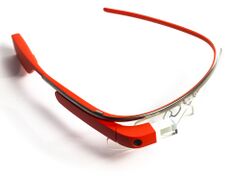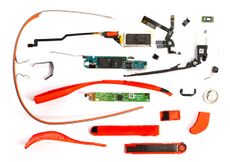Google Glass
Google Glass is a smartglasses product developed by Google. It shows 2D information similar to basic smartphone or smartwatch apps. Google Glass allows the user to interact with the gadget in a hands-free manner. Users can use gestures and voice commands to interact with Google Glass.
It was announced April 2012. It has a resolution of 640x360. It weighs 43 grams.[1]
Google Glass was initially released on April 15, 2013 for 1,500 dollars for a limited time. It became available to general public on May 15, 2014. On January 15, 2014, Google ended the production of the Google Glass but pledged that they were still working on the project.
Google Glass Enterprise Edition or Google Glass 2 was announced.
Hardware[edit]
Google Glass can be worn by itself or attached onto eyeglass frames. Its uses a Field Sequential Color LCoS to project rendered images. When images are synthesized, these images are passed through a series of lens elements that direct them to the user's retina. The user perceives a small translucent screen hovering at about arms length, extended up and outward from the right eye. The position of the screen layer depends on the position of Google Glass.
Google Glass has a touchpad on the side of its device. It allows user to slide through apps, events and other timeline-like interfaces.
Google Glass' camera can take 5MP photos and 720p videos.
Specifications[edit]
| Part | Spec |
|---|---|
| CPU | Texas Instruments OMAP 4430 SoC, dual-core |
| Memory | 2GB RAM |
| Storage | 12 GB of usable storage, 16 GB Flash total. |
| Display | Himax HX7309 LCoS display |
| Resolution | 640 × 360 |
| Camera | Photos - 5 MP, Videos - 720p |
| Audio | Bone Conduction Transducer |
| Connectivity | Wi-Fi - 802.11 b/g 2.4GHz, Bluetooth, microUSB |
| Power | 570mAh Internal lithium-ion battery |
| Weight | 43g (1.51oz) |
Interaction[edit]
Voice Commands[edit]
To activate voice commands, the user of either tilt his or her head 30 degrees upward or tap the touchpad then say "O.K. Glass". User will see a list of available voice commands. User can say one of the commands or scroll through the list by tilting his or her head up or down.
More voice commands become available when you enable Glassware in MyGlass app.
Apps[edit]
MyGlass is Google Glass' companion app for Android and iOS. The app allows users to set up, manage and configure their Glass.
Apps for Google Glass include a suite of Google's own apps include Google Now, Google Maps and Gmail and apps created by third-party developers such as Evernote, New York Times and Path.
Development[edit]
Development of augmented reality apps for Google Glass is made very accessible thanks to several SDKs that are currently available with Wikitude SDK being the most popular. The SDK enables developers to take advantage of built-in image recognition and tracking technology, position-aware services with geo-referenced data, embed videos from YouTube or Vimeo, and more. It allows anybody who is interested in augmented reality and object recognition to quickly develop a new application and showcase just how this technology could be integrated with our daily lives. Other solutions include, for example, CraftAR.
History[edit]
Developed by Google X, Google Glass was publicly revealed on April 5, 2012 when Sergei Brin wore one to Foundation Fighting Blindness event in San Francisco.
In April 15, 2013, Google Glass became available to developers attending Google I/O for 1,500 dollars.
It became available to general public on May 15, 2014 for 1,500 dollars.
On January 15, 2014, Google ended the production of the Google Glass but pledged that they were still working on the project.

